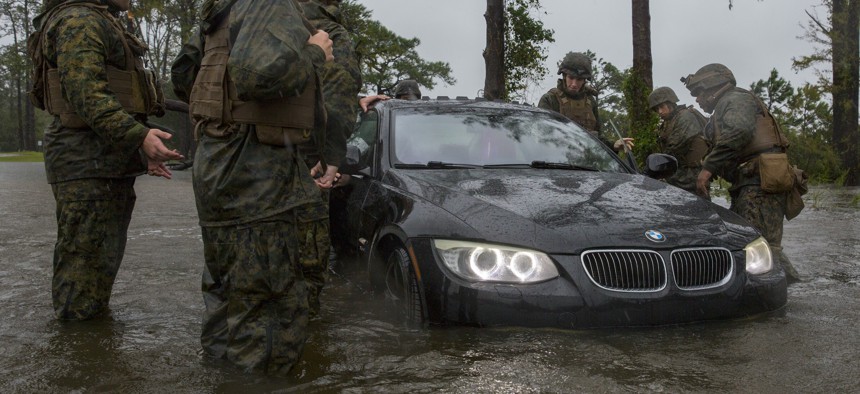
Marines with Marine Corps Base Camp Lejeune help push a car out of a flooded area during Hurricane Florence, Sept. 15, 2018. U.S. Marine Corps / Lance Cpl. Isaiah Gomez
Navy Climate Strategy Lacks Specifics for Reducing Largest Emissions Producers
Climate change is “one of the most destabilizing forces of our time,” Assistant Navy Secretary Meredith Berger said.
The Navy Department’s new climate strategy offers some specific goals for reducing greenhouse gas emissions from its vehicles and buildings, but outlines no goals for reducing emissions from its largest source of energy usage: ships and aircraft.
Climate change is “one of the most destabilizing forces of our time,” Meredith Berger, the assistant Navy secretary for energy, installations, and environment, told reporters ahead of the release Monday of the Navy Department’s Climate Action 2030. “These increasingly harsh and extreme weather conditions and other impacts that we see mean that our forces need to operate in different, more complex environments while simultaneously impacting our capacity to respond.”
Last year, President Joe Biden ordered the federal government to “put the United States on a path to achieve net-zero emissions, economy-wide, by no later than 2050.” The Defense Department responded in October with its own climate plan and five lines of effort that the Navy mirrored in its new strategy. Secretary Del Toro listed climate change as one of the four “most pressing challenges” facing the department in his October 2021 strategic guidance, along with China, culture, and COVID.
The new document lists five “specific targets,” including having all electricity through “carbon pollution-free” means by 2030; acquiring 100 percent zero-emission vehicles by 2035; and halving building emissions by 2032.
But about three-quarters of the department’s total emissions are produced by ships and aircraft, which are hard to “decarbonize,” because of their missions, the amount of energy required, and their long service life.
“There is a driving need to decrease that dependency and increase that resilience, because it will make us better at being warfighters, better at accomplishing our mission because we'll be able to stay on station longer,” she said.
In the strategy’s second line of effort, the department says it will address these operational emissions by focusing on initiatives that decrease emissions while increasing capability as part of the government’s net-zero emissions goal by 2050. The Navy will continue its efforts with “hybridization, electrification, alternative lower-carbon fuels, and advanced propulsion solutions for both existing and future tactical platforms in all domains,” the document said, without providing any specific emission reduction goals related to ships and aircraft. It does add that the Navy will continue to “explore hybrid and advanced propulsion options for all ships including future frigates and destroyers.”
Berger said department leaders would have 90 days to figure out which initiatives and goals to undertake and send a plan to Navy Secretary Carlos Del Toro for approval. He will also issue guidance on how the department will work to meet the strategy’s goals.
“We will be basing our efforts on data, on science, on metrics, so that we can set a course forward and make sure that we are achieving what we seek out to do,” Berger said.
The strategy sets at least some of its deadlines for 2030 because “the scientific community has been clear that this is the decisive decade in which the world must make meaningful progress if we are to avoid the most catastrophic impacts of climate change,” the document said.
The president’s 2023 budget request includes billions of dollars to reduce fuel consumption, harden bases against extreme weather, and do other things to address climate change. That includes $719 million to support the Navy’s climate initiatives. Berger did not say how much the Navy would spend to meet the Climate Action 2030 goals.
Sea-level rise already affects how the Navy repairs ships, how they train, and the operations of installations like Marine Corps Recruit Depot Parris Island in South Carolina, which could be three-quarters under water at high tide by 2099, the Associated Press reported. Rising ocean temperatures will also mean sailors and Marines will have to respond to more severe storms, according to the document. The west coast is also seeing effects with higher temperatures and wildfires, Berger said.




